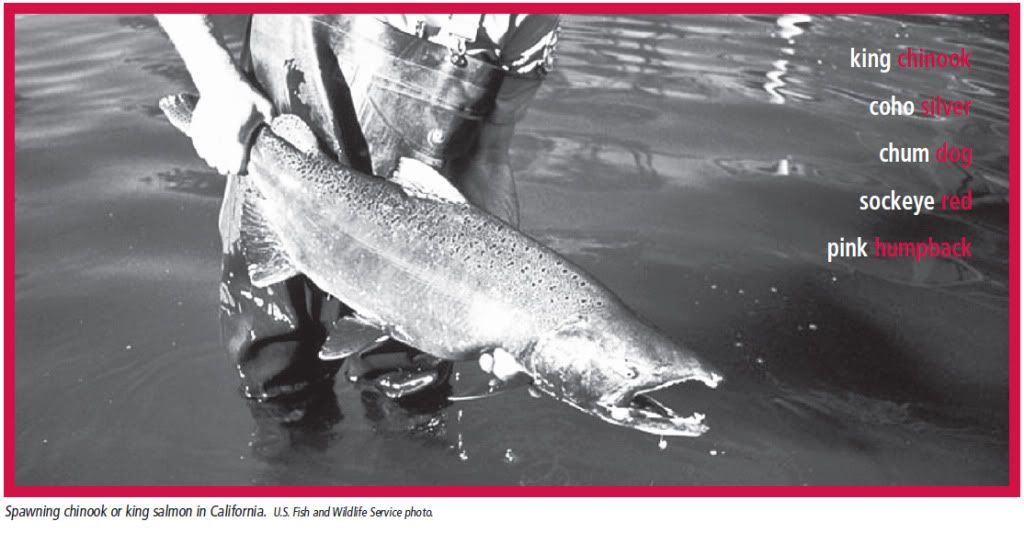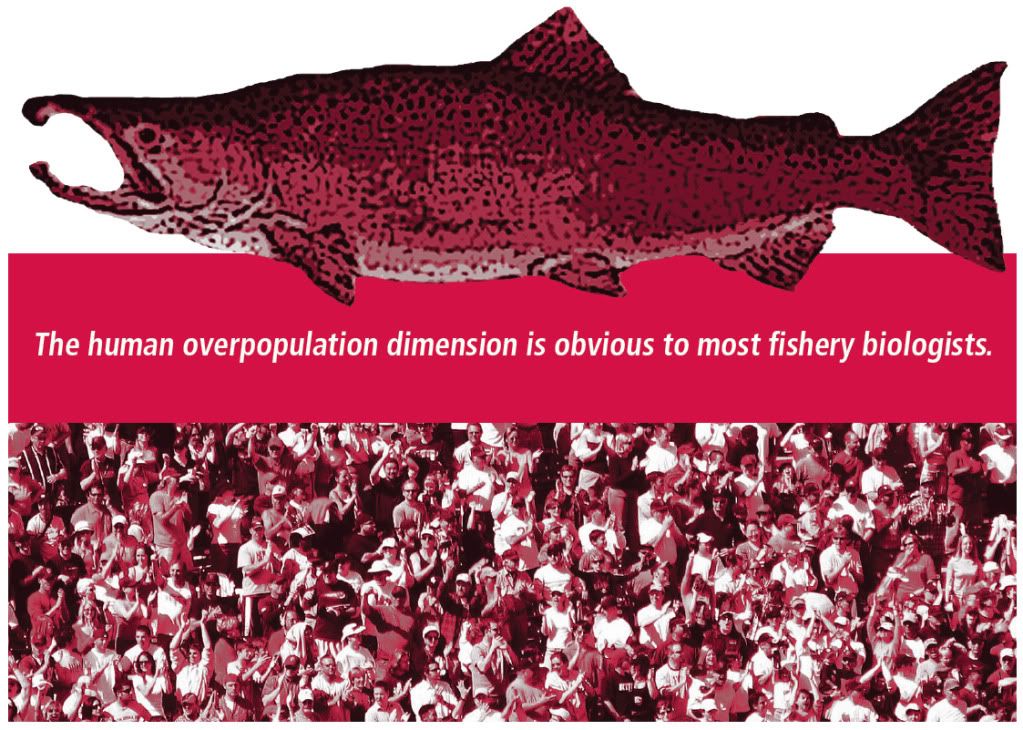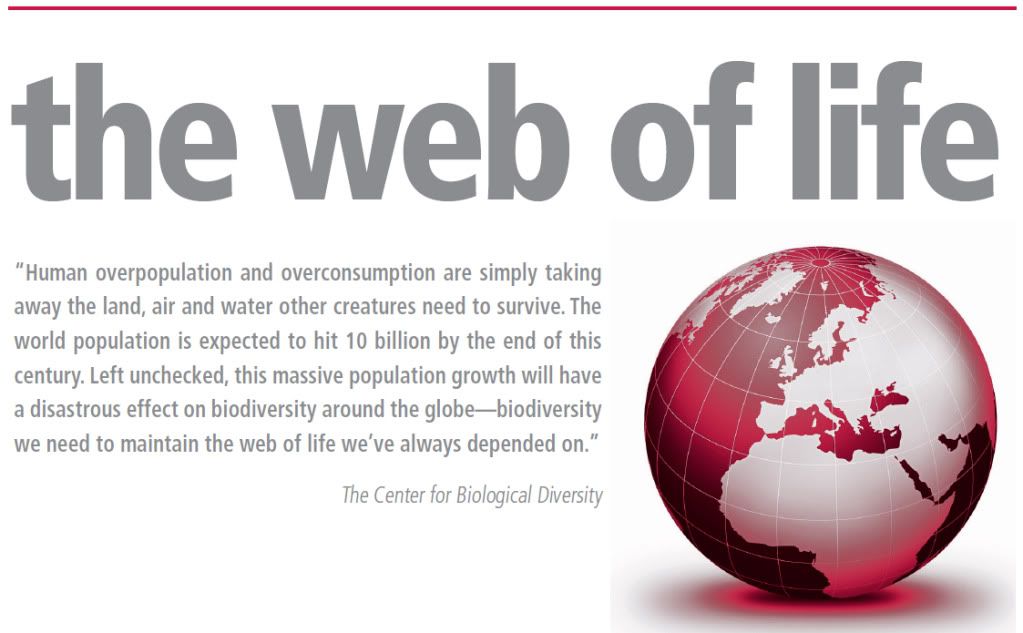Overpopulation Overwhelms Salmon
Published on April 16th, 2012
PDF Download: caps_issues_salmon_1.pdf


Zoologists refer to a select few species of wild creatures as “charismatic.” That is, they possess one or more characteristics we humans find immensely admirable or attractive—for example, their size, cuteness, ferocity, swiftness, intelligence, regality or agility—such that they attract a wide and devoted following.
Think polar bears, pandas, elephants, koalas, chimpanzees, whales, dolphins, bald eagles.
And salmon. Salmon are legendary and loved in western North America for their sleek and silvery beauty; for their importance to economies, livelihoods, sport-fishing and diet; for their uncanny ability to navigate back to their home streams after far-flung odysseys in the ocean; for the dramatic changes in color and shape they undergo when reproducing; and for the pathos they inspire when they die en masse after spawning and fulfilling their obligation to future generations.
Salmon symbolize the timeless circle of life. Their life cycle—from hatching to their youth in their natal or home watersheds, their reckless ventures out into the wild world of the open ocean where they encounter perils and possibilities galore, and then a final return home to mate and, after this climax, to die—evokes our empathy, touching a chord deep inside us. As different as we are from these strange and marvelous fish, there are parallels in the trajectories of our lives.
Salmon are also symbols of wilderness and of healthy ecosystems. And throughout much of their original range, they are in trouble. The demise of salmon in so many areas symbolizes the manmade stresses to which ecosystems have been subjected.
Five species of native salmon in the taxonomic family Salmonidae and the genus Oncorhynchus inhabit the waters of the Pacific Coast of North America. Each has at least two names by which they are commonly known. From largest to smallest, they are the king or chinook, coho or silver, chum or dog, sockeye or red, and pink or humpback.
These anadromous fish hatch in freshwater ecosystems, where they reside as “fry” and “fingerlings” for a matter of just days (pinks) to some years (cohos). Their freshwater habitats include rivers, streams, sloughs, marshes, lakes and ponds. After one to three years, these juveniles become smolts—their vertical parr marks fading and their delicate scales glazed with silver—and they undergo internal physiological adjustments to be able to survive in saltwater. Then they float and swim downstream, eventually emerging into an ocean filled with food … and with foes.

Those that survive predators and human fisheries grow prodigiously in the productive sea. Coho salmon, for example, increase their weight by 400 times in just 16 months. “After a comparable growth spurt, a hundred-pound human adolescent would crush the scale at almost forty thousand pounds,” I wrote in my 1993 book, Where Salmon Come to Die: An Autumn on Alaska’s Raincoast. But of those juvenile salmon that depart for the sea, less than one in ten will survive to return, spawn and bequeath genes to its progeny.
Unfortunately, as human numbers soared on the west coast of North America in the 20th century, salmon numbers sank. California’s population alone skyrocketed from about 2 million in 1900 to 35 million in 2000. It is no coincidence that salmon runs are in the worst shape in overpopulated California and in the best shape in thinly populated Alaska.
Why? Because high human population density—and intensive exploitation of the landscape to support those human populations— modify and degrade both terrestrial and aquatic habitats needed for healthy and abundant salmon populations. Urban sprawl and runoff, dams, logging and deforestation, road-building, mining, erosion, siltation, turbidity, reduced and altered instream water flows from diversions for agricultural irrigation and pesticides all damage salmon spawning and rearing habitats, block migration or directly harm the fish themselves.
Overfishing has been the coup de grace for these weakened populations.
In unblemished, intact ecosystems, like those which still endure in portions of Alaska’s Tongass National Forest, salmon themselves nurture the forest which in turn nurtures them. In a lovely chapter entitled “What goes around comes around” in her book, Salmon in the Trees, photographer Amy Gulick writes of a forest, “fertilized with supercharged soil from decayed fish.”
As we used to say when I worked as a fishery technician for the Alaska Department of Fish and Game, these unlogged, ancient forests are “fish factories.” Multi-million dollar efforts—or “techno-fixes”— to restore salmon in California, Oregon and Washington have had mixed results at best. Fish hatcheries, for example, sprang up on the West Coast after World War II as a means of countering the adverse impacts mentioned above.
In the same era of techno-optimism and hubris that beguiled us into believing that technology could outdo Nature in many respects—for example, replacing mothers’ breast milk with powdered infant formula—we deluded ourselves into thinking that hatcheries could substitute for, or even one-up, natural fish factories (pristine spawning and rearing habitats) that had been defiled and degraded by development.
Research by fishery scientists in recent decades shows that, for a variety of subtle reasons, hatcheries can often undermine the viability of the very wild salmon stocks that they were built to restore.
Sometimes this happens from overstocking streams with too many fish, exceeding carrying capacity and weakening all fish, and sometimes from hybridization between wild and hatchery fish, diluting the unique, adaptive genomes of particular stocks. Sometimes it’s the result of introducing diseases. At the hatchery on the Mokelumne River in California’s San Joaquin County, massive numbers of hatchery-raised fish have only served to mask declining wild stocks.

The situation is bad not just for the fish, but for the fishermen. By 2008, the salmon harvest in California had shriveled to the point that the Pacific Fishery Management Council shut down the entire coastal salmon fishery in the state, throwing many commercial fishermen out of work.
The human overpopulation dimension is obvious to most fishery biologists. Twenty years ago, after I had taken a position as an environmental planner in California, my old boss in the Alaska Department of Fish and Game told me: “Your sacred mission as a planner is to keep California just livable enough that those 30 million people won’t move north!”
Overpopulation in California compromises livability and sustainability not just for human beings, but for salmon as well. Preventing the state from becoming even more overpopulated will improve prospects both for Homo sapiens and Oncorhynchus spp who continue to call this damaged but still-remarkable state home.






